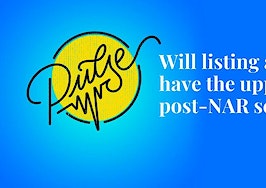As life slowly returns to some sense of normalcy, sellers who have their homes on the market or are planning to put them on the market may be wondering what the process will look like now. There are probably a million questions running through their minds.
When and where will buyers come from? Will interested buyers have to sell their homes in order to buy? With rising unemployment levels, how can a buyer’s financial stability be guaranteed? How long will it take to close?
Not to mention, if plans involve finding another property or relocating to another area entirely, there is likely to be even more trepidation as to how the process will unfold.
As we adjust to going about life against the backdrop of a pandemic, here are five challenges sellers are currently facing and how to overcome them.
1. Overcoming concerns regarding showings
When sellers put their homes on the market, it used to be that tons of showing appointments was a good thing. Open houses? Keep ’em coming — with delicious treats and cold lemonade on a warm afternoon. Do whatever it takes to create a sense of urgency and a feeding frenzy among potential prospects wanting to come through the front door.
Now? Well, not so much.
Sellers may be somewhat hesitant, even if they don’t vocalize it, when it comes to strangers walking through their homes. They may feel subtle pressure to just go along with the process and hope all will be OK.
But there are so many things they might be thinking about. Like, will buyers and agents take proper precautions? Will they really wear masks and gloves and avoid touching things around the house? Depending on the location of the property, how will these safety procedures be enforced?
There’s still a lot of uncertainty about how coronavirus is actually transmitted, and people’s concerns should never be minimized or taken lightly. No matter how much we try to take precautions, as agents, every time we interact with someone, we risk exposure to the virus. This can, in turn, pose a risk to everyone else that we come in contact with.
To provide sellers some reassurance, share the showing instructions you’re communicating to agents — something that lists what will be expected of them and their buyers. But there are a few more things you can do.
Post a sign near the home’s entrance that reminds agents and buyers to wash their hands, wear masks and practice social distancing while inside the property. (Some states like California require a notice to be posted in every property for sale.) Place a supply of gloves, masks and disinfecting wipes, along with a small garbage or plastic bag by the front door so that everyone can dispose of these items once they leave.
Some states and localities are requiring a form to be signed by the selling agent and buyers before seeing a home, attesting that they have not been feeling ill or have been exposed to someone who may have had the virus. In other markets, the state or local association of Realtors may have a similar form, though it’s usually not required.
Whether it’s required or not, implementing a form like that is good practice. It also helps provide some documentation as to who entered the property.
In addition, ask your buyers and their agents to view the property online before seeing it in person. This includes watching all property videos and virtual tours so they have a good grasp of what the home looks like and if it’s truly a potential fit.
Hopefully, this will help sellers avoid ill-matched showings and feedback like: “Oh, they wanted a first-floor master bedroom, and the home didn’t have one.”
Agents can definitely screen for this ahead of time by taking a closer look at property information, assuming the listing makes it clear, of course. Buyers often don’t know and are overwhelmed after skimming through photos of numerous properties, but a skilled agent who knows the inventory and how to look at photos with a critical eye can often tell if a property truly meets a buyer’s requirements.
If the listing information is not clear, it’s best to confirm with the listing agent before scheduling a showing (particularly in our current environment) to minimize inconvenience to sellers.
Manage showings with a close hand, reminding agents prior to their showing of the requirements and the importance of following protocols at the request of the seller, whether mandatory or not.
2. Lack of buyer traffic
The pandemic brought showing activity to a halt in numerous markets. Depending on the severity of the virus and levels of shelter-in-place orders, some areas have been more affected than others. As a seller, there is nothing worse than that feeling of uncertainty that comes from lack of activity when a home is on the market.
Work with sellers on adjusting expectations in this new reality. If the location of their home is heavily dependent on out-of-area buyers, explain why that could lead to a decline in physical showing traffic.
Clearly, it’s going to take some time for people to feel comfortable about traveling again. Even if they choose to do so by car, the idea of going into restaurants and staying in an unfamiliar place, such as a hotel or even a vacation rental, is more concerning than it once was. Combine that with reduced airline schedules, and you can see why buyers may not feel as inclined to travel across the country as they did six months ago.
Reach out to agents in areas that you consider feeder markets, and put your finger on the pulse of what’s happening there. This will also help you get a true “boots on the ground” perspective. You can discuss your property in the event one of their customers may find it of interest.
If local buyers are more suited to the property you are selling, engage with other agents who also have listings around yours to find out what they’re seeing.
Transition to the use of video and virtual open houses to help bring the property closer to wherever buyers may be. Consider creating a variety of video content to post on social media to promote the listing and create engagement.
When it comes to the state of the market around their home, communicate as much information as you can with sellers — like the number of competing listings, properties under contract and any recently closed sales. Relay any trends you’re seeing with respect to price ranges that are moving versus sitting, and more.
3. Financial strength of buyers
Let’s face it, the economy is not the same as it once was. Unless it’s the cleaning product, personal protection or coronavirus testing and vaccine business, you would be hard-pressed to find an industry that hasn’t been affected in one way or another by the pandemic.
This means a buyer’s job stability has either already been affected or will be in the future. Besides layoffs, many people have been temporarily furloughed, have taken significant pay cuts or had their hours reduced. These situations hamper the ability for someone to qualify for a mortgage loan. So, there are likely less buyers for certain price points of homes than there previously were.
That being said, any buyer who makes an offer on a home today needs to be vetted to ensure they can get to the closing table. A seller may be skittish about accepting an offer and taking their home off the market without knowing they can get to the finish line.
While nothing can be guaranteed with absolute, 100 percent certainty, there are numerous things that can be done to help manage the process and let the seller know that you’ve done everything in your power to ensure the buyers are the real deal.
Consider requiring buyers to provide a preapproval letter or proof of funds (sourcing down payment and the binder or escrow deposit — even if obtaining a mortgage) prior to confirming the showing.
While this tactic has been done in some super competitive markets for many years, in other markets, agents may be operating under “looser” customs and not asking for these things. There’s no sense in wasting time and risking potential exposure to a seller’s home if a buyer is not willing to produce these documents ahead of time.
Require any buyer who submits an offer to be “cross-qualified” with a local lender that you do business with and consider to be very thorough. That way, you’ll get another set of eyes to look at the buyer’s financial picture and ensure there aren’t any potential “gotcha(s)” that may have been glazed over while the buyer was getting approved with another lender.
Lending guidelines have changed. They may have been told one thing, but requirements now dictate a slightly higher interest rate due to the amount the buyer is putting down. This is important with respect to the jumbo loan market or buyers on the bubble when it comes to debt-to-income ratios and credit scores.
Also, as a condition of accepting an offer, consider asking the buyer to work with a local lender. Someone who’s out of state might not be as familiar with local customs regarding closing costs, required inspections and more. Working with a local lender will ensure a smoother process.
It may also help you avoid appraisers who hail from the hinterlands, have little to no knowledge of the neighborhood they’re conducting an appraisal in and end up bringing the value of the property well below market value.
4. Buyers may have a home to sell in order to buy
Although the traditional buyer pool may be somewhat diminished, there are likely going to be more buyers who can buy, but need to sell their current property in order to do so. While this is never an ideal scenario, there are ways to work through it, even during the COVID-19 pandemic.
Sellers need to remain flexible and open to working with offers subject to a home sale contingency as this could be the “new normal” for the next few months. Sellers who live in favorable areas with respect to climate and affordability could see an influx of buyers choosing to relocate on an elective basis.
One way to manage offers with a home sale contingency? Place a time frame by which buyers have to get their homes under contact. That way, the seller won’t take their home off the market with a buyer for an open-ended period of time.
The seller could also ask for a continued marketing addendum — often referred to as a right of first refusal — which would allow the seller to accept the buyer’s contingent offer on their home sale, but continue to market and show the property.
Should another offer be made that doesn’t have a home sale contingency, give the buyer in first position 24, 48 or 72 hours to lift their contingency or step aside so the seller can work with the other offer. A continued marketing addendum is also a beneficial way to provide the seller leverage when dealing with another offer.
5. Managing the closing and moving process
It’s never fun to pack up and move, whether it’s a short jaunt around the corner or a long transition across the country. Add to that the stress and uncertainty brought on by the pandemic, and it’s easy to see why sellers are so skittish about packing up and moving out before it’s truly a done deal.
When conducting transactions in our current environment, potential delays and some level of uncertainty are bound to occur. So, consider asking the seller to give possession within a certain number of days after closing to a buyer. That way, sellers don’t have to upend their lives, only to find out the day before closing that the buyer lost their job or had their salary substantially reduced and is no longer qualified to buy the home.
A post-occupancy agreement can be executed if the seller occupies the home after closing for a relatively short period of time. If it’s going to be longer, a rental agreement may need to be executed.
Make sure that you have everything spelled out from the parties securing proper insurance as to who is responsible for utilities, lawn or pool maintenance, as well as damage.
Although it may be difficult to find a buyer with an ideal situation in these uncertain times, there are ways to cut through the uncertainty and make the listing process as productive and seamless as possible.
Cara Ameer is a broker associate and global luxury agent with Coldwell Banker Vanguard Realty in Ponte Vedra Beach, Florida. You can follow her on Facebook or Twitter.
After 25 years, Inman Connect is coming to you. We’re transcending our legendary events in a live digital event, Inman Connect Now. Get ready for the top industry leaders plotting the path forward, new business ideas and opportunities, networking like you’ve never imagined it, and tons of exciting new magic, all straight to you. It’s all part of an epic new Inman experience, Connect Now, June 2-4, 2020. Click here to save your seat.













